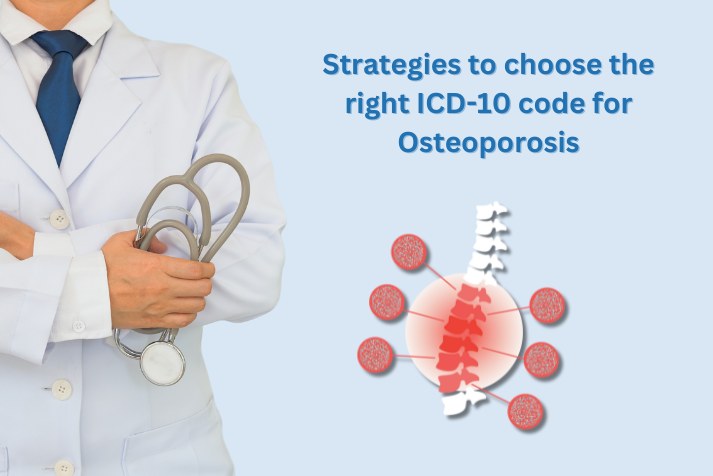It is a complicated task in medical billing to choose the right ICD-10 code for numerous diseases. When it comes to identifying the accurate ICD-10 code for conditions like Osteoporosis. As a healthcare provider and medical coder, it is crucial to understand the coding guidelines. It helps to boost reimbursement rates and provide proper treatment to patients. In this blog, you will unlock coding guidelines and the most commonly used ICD-10 codes for osteoporosis.
Introduction to Osteoporosis
Osteoporosis is a skeletal disorder where bones become weak and brittle. It can lead to fractures and height loss. Regular exercise and a healthy diet rich in calcium and vitamin D can help prevent it. Getting regular bone density tests to detect and manage osteoporosis is important. It is more common in older adults, especially women. However, it can occur in men and younger individuals as well.
Factors associated with Osteoporosis
Understanding the risk factors is crucial for the prevention of osteoporosis, and the effective management of this condition. Here are key factors:
- Age
- Gender
- Family History
- Hormonal Factors
- Low Bone Density
What are the billable ICD-10 codes for Osteoporosis
Osteoporosis, which impacts bone density, may manifest with or without pathological fractures. When associated with a current pathological fracture, it is typically classified as age-related.
M80 Osteoporosis with current pathological fracture.
- M80.0 Age-related osteoporosis with current pathological fracture
- M80.00 Age-related osteoporosis with current pathological fracture, unspecified site
- M80.01 Age-related osteoporosis with current pathological fracture, shoulder
- M80.011 Age-related osteoporosis with current pathological fracture, right shoulder
- M80.012 Age-related osteoporosis with current pathological fracture, left shoulder
M80.02 Age-related osteoporosis with current pathological fracture, humerus
- M80.021 Age-related osteoporosis with current pathological fracture, right humerus
- M80.022 Age-related osteoporosis with current pathological fracture left humerus
M80.03 Age-related osteoporosis with current pathological fracture, forearm
- M80.031 Age-related osteoporosis with current pathological fracture, right forearm
- M80.032 Age-related osteoporosis with current pathological fracture left forearm
M80.04 Age-related osteoporosis with current pathological fracture, hand
- M80.041 Age-related osteoporosis with current pathological fracture, right hand
- M80.042 Age-related osteoporosis with current pathological fracture left hand
M80.05 Age-related osteoporosis with current pathological fracture, femur
- M80.051 Age-related osteoporosis with current pathological fracture, right femur
- M80.052 Age-related osteoporosis with current pathological fracture left femur
M80.06 Age-related osteoporosis with current pathological fracture, lower leg
- M80.061 Age-related osteoporosis with current pathological fracture, right lower leg
- M80.062 Age-related osteoporosis with current pathological fracture left lower leg
M80.07 Age-related osteoporosis with current pathological fracture, ankle, and foot
- M80.071 Age-related osteoporosis with current pathological fracture, right ankle, and foot
- M80.072 Age-related osteoporosis with current pathological fracture left ankle and foot
M80.8 Other osteoporosis with current pathological fracture
- M80.81 Other osteoporosis with pathological fracture, shoulder
- M80.82 Other osteoporosis with current pathological fracture, humerus
- M80.83 Other osteoporosis with current pathological fracture, forearm
- M80.84 Other osteoporosis with current pathological fracture, hand
- M80.85 Other osteoporosis with current pathological fracture, femur
For osteoporosis without pathological fracture, codes from the M81 series can be used.
- M81 Osteoporosis without current pathological fracture
- M81.0 Age-related osteoporosis without current pathological fracture
- M81.6 Localized osteoporosis [Lequesne]
- M81.8 Other osteoporosis without current pathological fracture
Documentation and Coding Guidelines for ICD-10 code for Osteoporosis
When coding for osteoporosis in ICD-10, specifically using the code M81.0 for age-related osteoporosis without current pathological fracture, it’s important to follow certain guidelines to ensure accuracy and compliance. Here are three simplified guidelines to help with the process:
- Identify the Type of Osteoporosis: Before using the M81.0 diagnosis, ensure that the medical record indicates the patient has age-related osteoporosis without current pathological fractures. This code is specifically for cases where osteoporosis is due to aging and does not involve a fracture at the time of diagnosis.
- Check for Current Pathological Fracture: If the patient has a current pathological fracture due to osteoporosis, a different code should be used instead of M81.0. The ICD-10 system has specific codes for osteoporosis with current fractures that vary depending on the fracture’s location.
- Use Additional Codes for Risk Factors: If the patient has any known risk factors for osteoporosis (like long-term use of steroids) or related conditions (such as vitamin D deficiency), you should use additional codes to provide a complete picture of the patient’s health status.
How does the ICD-10 code for a family history of osteoporosis impact on reimbursement rate
When using the ICD-10 code Z82.62, which represents a family history of osteoporosis, it can influence reimbursement rates by highlighting a patient’s increased risk for developing osteoporosis. This specific code, although not directly related to the patient’s current health status.
But it is essential for preventive measures. It tells insurance companies that someone might be more likely to get osteoporosis because it runs in their family. This information is important because it can lead to the insurance paying for early tests or treatments to help prevent osteoporosis, which can save money in the long run.
In addition, the use of ICD-10 codes for osteoporosis M81.0 directly impacts reimbursement. These codes justify the medical necessity for treatments, medications, or procedures. It potentially leads to higher reimbursement rates for healthcare providers.
Proper coding ensures that healthcare services are accurately documented, facilitating appropriate reimbursement for managing these conditions. It reflects the clinical severity and the required resources for patient care. It influences the financial support received from insurance companies for the treatment provided.
Conclusion:
Overall, accurately selecting the right ICD-10 codes for osteoporosis is not just about fulfilling a billing requirement, it’s about ensuring patients receive the proper care. They need to optimize reimbursement rates for healthcare providers. By understanding and applying the specific codes for osteoporosis, with or without pathological fractures, healthcare providers can highlight the severity and necessary treatment for each patient. This approach not only supports the financial health of medical practices but also contributes to the early detection and management of osteoporosis.




